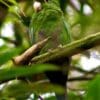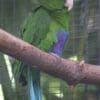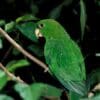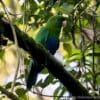Purple-bellied Parrot
Also known as:
Blue-bellied Parrot, Purple-breasted Parrot, Violet-bellied Parrot
Also known as:
Blue-bellied Parrot, Purple-breasted Parrot, Violet-bellied Parrot
DID YOU KNOW?
The male Purple-bellied Parrot displays by walking with head lowered and mantle raised, pushing his beak along the perch. He spreads his tail and sings while shaking his head quickly, then rubs his bill on the branch. The female shakes her head and sings.

Triclaria

malachitacea
Size:
28 cm (11 in)
Weight:
110-155 g (3.8-5.4 oz)
Subspecies including nominate:
one
Colour Adult:
Male-an all-green parrot, with purple/blue on centre of abdomen and lower breast. Beak pale horn in colour. Eye ring grey. Eye brown. Female-underparts green.
Colour Juvenile:
As in adults but males show minimal purple/blue on centre of abdomen, and lower breast is green.
Call:
Calls are described as distinctive and song-like; trilling notes. Also rapidly repeated squeaking notes. Captive birds have been heard to duet with one another.
More Information:
Content Sources:
CITES
BirdLife International
Cornell Lab of Ornithology/Birds of the World
A Guide to Parrots of the World, Juniper and Parr, 1998
Parrots: Status Survey and Conservation Plan 2000-2004, Snyder, McGowan, Gilardi, Grajal, 2000.
Parrots of the World, Forshaw, 2006. 2010 edition
Parrots in Aviculture, Low, 1992.
Lexicon of Parrots, Thomas Arndt.
Parrots: Their Care and Breeding, Low, 1986.
Captive Status:
Rare
Longevity:
—
Housing:
Walk-in, planted enclosure, minimum length 3 m (9.8 ft).
Diet:
Fruits such as: apple, pear, orange, banana, cactus fruits, pomegranate, forming about 30 percent of the diet; vegetables such as: carrot, celery, green beans and peas in the pod; fresh corn; green leaves such as: Swiss chard, lettuce, sowthistle, dandelion, chickweed; spray millet; small seed mix such as: canary, millet and smaller amounts of buckwheat, oats, safflower and a little hemp; soaked and spouted sunflower seeds; cooked beans and pulses, complete kibble.
Enrichment:
Provide as large an aviary as possible, planted, so this bird may have privacy and security. Fares better with other birds present; is more active and lively. Provide loose, bird-safe, unsprayed chewable branches (flowering, fir, pine, elder or willow).
Nest Box Size:
Vertical box 10″ x 10″ x 24″ (25.4 cm x 25.4 cm x 61 cm).
Clutch Size:
4
Fledging Age:
55-56 days.
Hatch Weight:
—
Peak Weight:
—
Weaning Weight:
—
World Population:
10,000-20,000 mature individuals, decreasing.
IUCN Red List Status:
Least Concern
CITES Listing:
Appendix II
Threat Summary:
Not globally threatened. A BirdLife “restricted-range” species. Is generally uncommon, however, is also highly unobtrusive so its status is largely unknown. Suffers from extensive habitat loss from agriculture, urbanisation and palmito collection. Tree cover within its range is lost at a rate of 5-6% over 11.6 years. Also is affected by moderate trade and hunting for food, but the effect has not been quantified.
Range:
Coastal S Brazil, from S Bahia and E Minas Gerais south to Rio Grande do Sul, and NE Argentina, in N Misiones.
Habitat:
Found from 300-700 m (984-2296 ft) in wet lower montane forest, bromeliad rich areas, cultivated areas and sometimes suburban areas.
Wild Diet:
Feeds on fruits, seeds, buds, bark, nectar and insects and their larvae. Takes seeds of Psidium, flowers of Aechmea ornata and fruits including epiphytic cacti and most notably Euphorbiaceae such as Pachystroma longifolium, Actinostemon concolor and Sebastiana. Also Myrtaceae, mainly Eugenia rostrifolia and Campomanesia xanthocarpa, plus cultivated maize and oranges.
Ecology and Behaviour:
Resident, with movements outside of breeding season. Usually seen in pairs or small groups. Quiet and shy. Active in early morning and again at dusk, feeding in lower to middle stages of the canopy.
Clutch and Egg Size:
4 eggs, 31.5 x 25.0 mm (1.2 x 1 in).
Breeding Season:
August-February. Nest is in cavity in old tree.
Related Links:
—
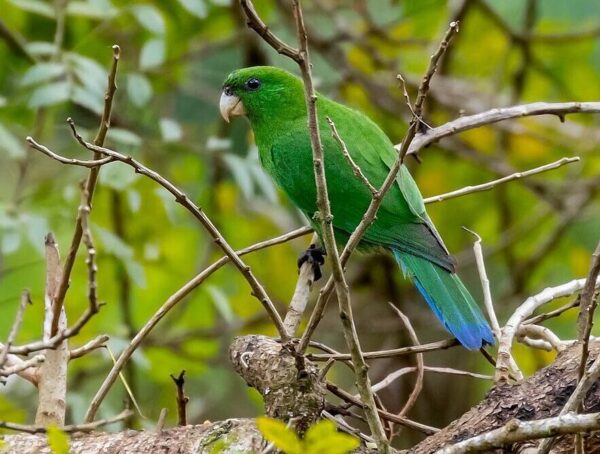
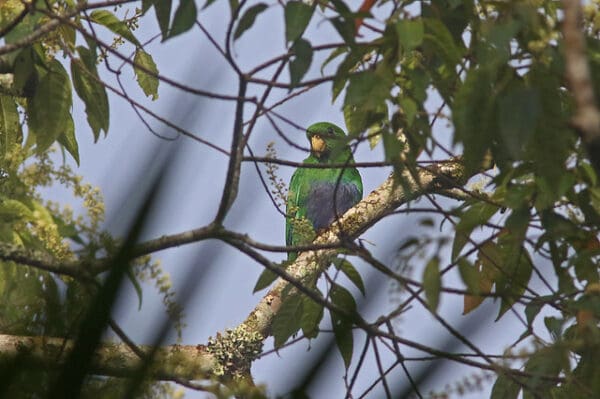
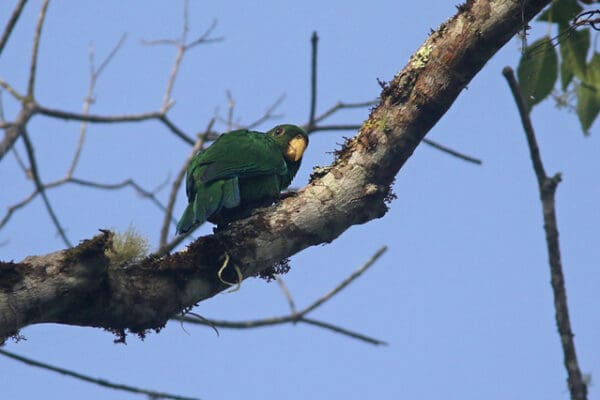
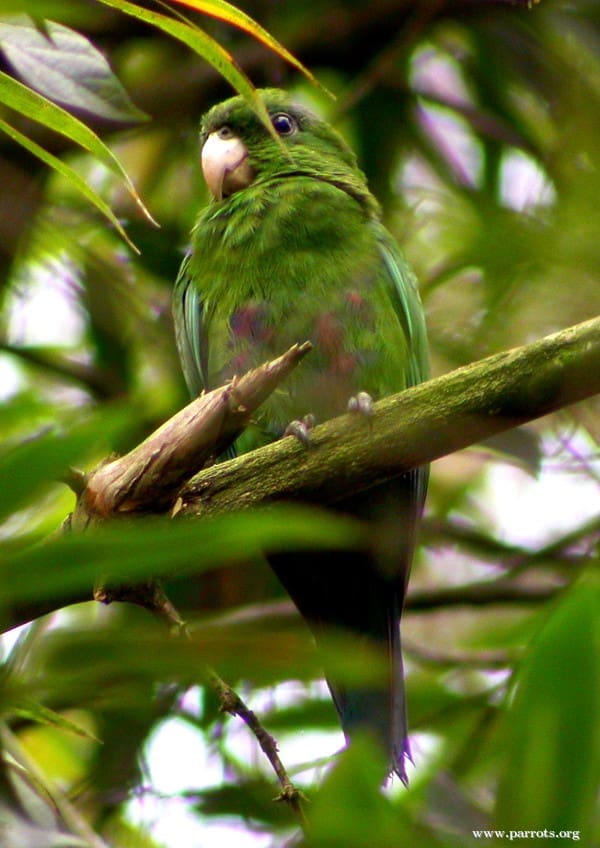
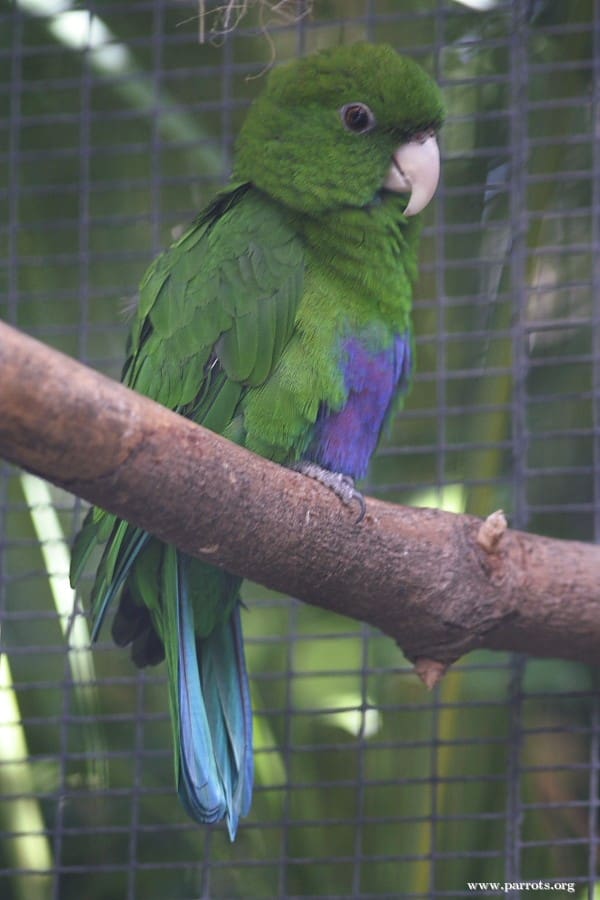
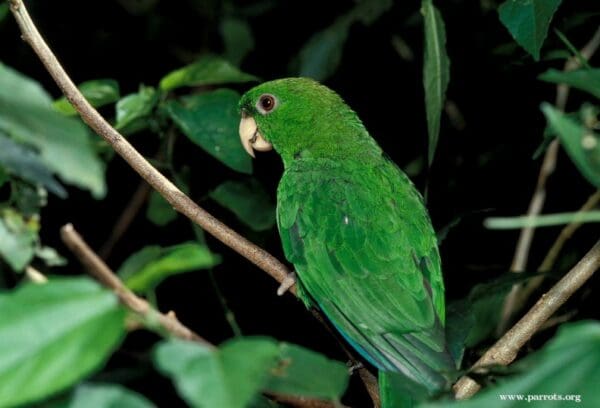
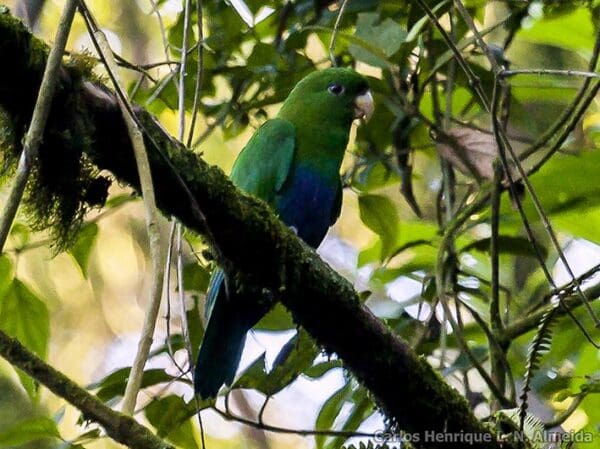
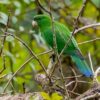
![© Brendan Ryan [CC BY-SA 2.0] via Flickr A wild Purple-bellied Parrot perches in a tree](https://parrots.org/wp-content/uploads/2023/01/wpt_Purple-bellied-Parrot_1426-7-100x100.jpg)
![© Brendan Ryan [CC BY-SA 2.0] via Flickr A wild Purple-bellied Parrot perches in a tree](https://parrots.org/wp-content/uploads/2023/01/wpt_Purple-bellied-Parrot_1426-6-100x100.jpg)
